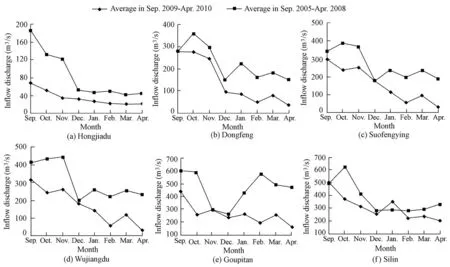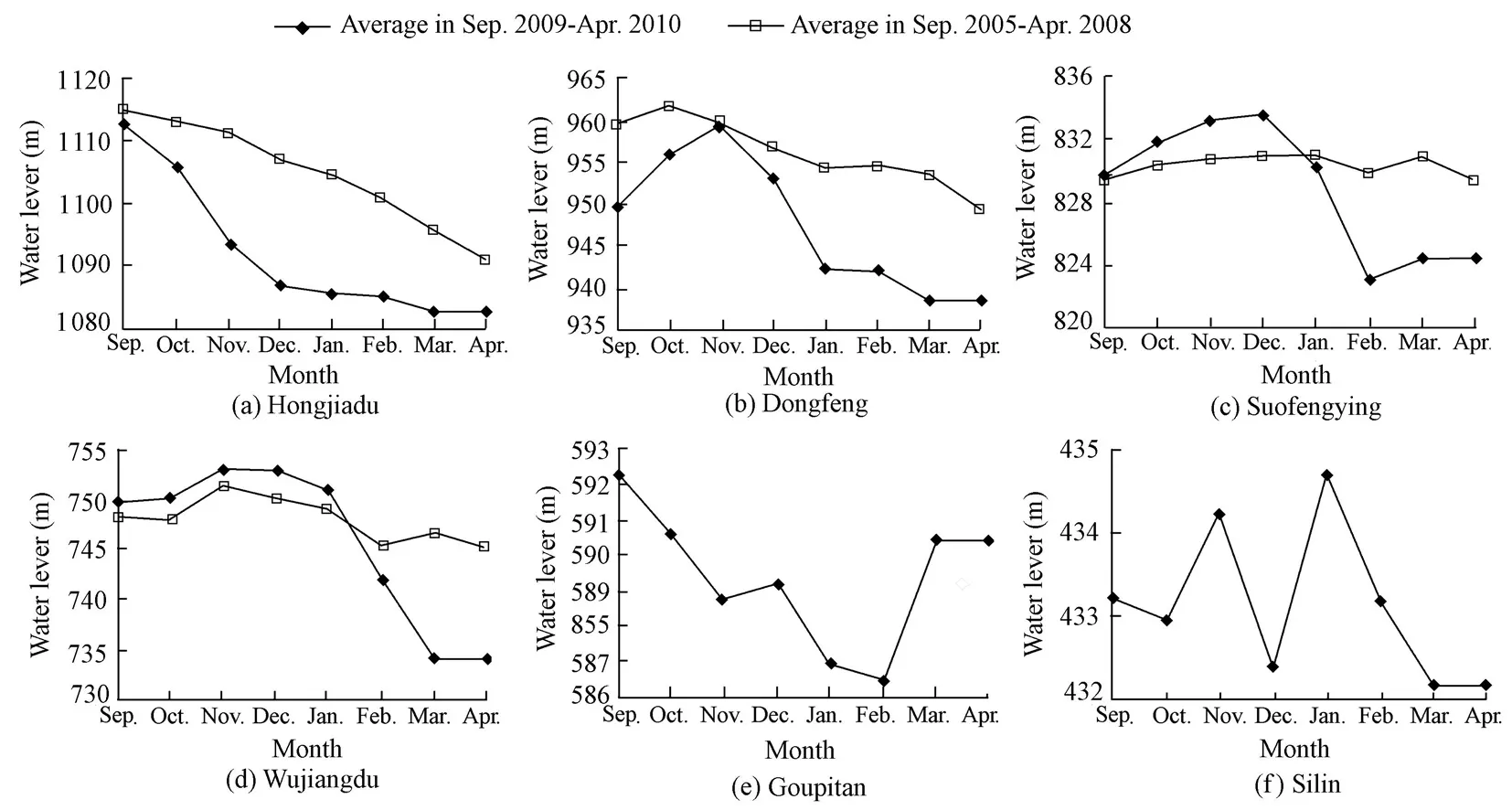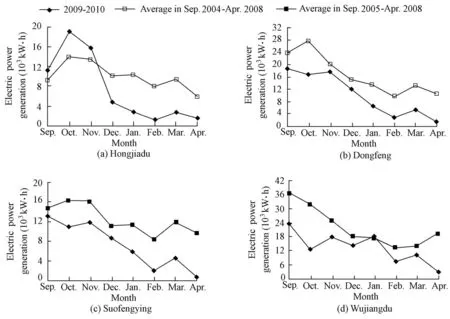Optimized operation of cascade reservoirs on Wujiang River during 2009-2010 drought in southwest China
2013-06-22XinSUISainanWUWengenLIAOLanJIATiantianJINXueZHANG
Xin SUI*, Sai-nan WU, Wen-gen LIAO, Lan JIA, Tian-tian JIN, Xue ZHANG
1. National Research Center for Sustainable Hydropower Development, China Institute of Water Resources and Hydropower Research, Beijing 100038, P. R. China
2. Guizhou Wujiang Hydropower Development Co., Ltd., Guiyang 550002, P. R. China
Optimized operation of cascade reservoirs on Wujiang River during 2009-2010 drought in southwest China
Xin SUI*1, Sai-nan WU1, Wen-gen LIAO1, Lan JIA2, Tian-tian JIN1, Xue ZHANG2
1. National Research Center for Sustainable Hydropower Development, China Institute of Water Resources and Hydropower Research, Beijing 100038, P. R. China
2. Guizhou Wujiang Hydropower Development Co., Ltd., Guiyang 550002, P. R. China
The effects of optimized operation principles implemented at reservoirs on the Wujiang River in southwest China between September 2009 and April 2010 under drought conditions were analyzed based on operational data collected from the Guizhou Wujiang Hydropower Development Co., Ltd. A set of linear regression equations was developed to identify the key factors impacting the electric power generation at reservoirs. A 59% reduction in the inflow discharge at the Hongjiadu Reservoir led to a decrease of only 38% in the total electric power generation at the Hongjiadu, Dongfeng, Suofengying, and Wujiangdu reservoirs on the Wujiang River, indicating that optimized operation can play an important role in drought management. The water level and the amount of other water inputs at the Hongjiadu Reservoir and the outflow discharge at all of the reservoirs except the Wujiangdu Reservoir were key factors affecting the total electric power generation at reservoirs on the Wujiang River under optimized operation.
southwest China drought; Wujiang River; cascade reservoir; optimized operation
1 Introduction
Weather events such as extreme variations in temperature, precipitation, and wind have recently increased in frequency and intensity (Bolin 2003; Hansen et al. 2005; Qin et al. 2007; RCC 2008; Chen and Fan 2010). For example, Guizhou Province suffered its worst drought in the last 80 years between September 2009 and April 2010, while sequential autumn, winter, and spring droughts simultaneously occurred in five other provinces in southwest China (Shao et al. 2008).
Decreases of precipitation and inflow caused by extreme weather events have a profound impact on the operation of cascade reservoirs. There have been many studies of reservoir operation in response to abnormal weather, most investigating the influence of precipitation (Xia et al. 2008a, 2008b), runoff (Shao et al. 2008), and inflow changes (Mirza 2009) caused by climate change. However, there have been few studies of the optimized operation ofcascade reservoirs in response to extreme weather.
In this paper, we discuss the development of optimized operation principles and their effects on the operation of reservoirs on the Wujiang River during the drought between September 2009 and April 2010. A set of linear regression equations was developed to identify the key factors impacting the electric power generation at the cascade reservoirs. The conclusions of the study may provide useful information for decision makers attempting to implement optimized operation of cascade reservoirs to address climate change effects.
2 Cascade hydropower stations on Wujiang River in Guizhou Province
The Wujiang River, with a length of 1 037 km and a natural head of 2 123.5 m, flows through Guizhou Province and is the largest tributary on the south bank of the upper reaches of the Yangtze River. It is one of the twelve largest sources of hydropower in China, with hydropower reserves totaling 9.785 × 106kW. The Guizhou Wujiang Hydropower Development Co., Ltd. is the first watershed hydropower development company in China, and is also the first case of watershed cascade hydropower station construction and integrated development implemented by the State Council in China. The company manages seven hydropower stations in Guizhou Province, including the Hongjiadu, Dongfeng, Suofengying, Wujiangdu, Goupitan, Silin, and Shatuo reservoirs, with a total of hydropower reserve of 8.305 × 106kW. The distribution and main technical parameters of the cascade hydropower stations are shown in Fig. 1 and Table 1, respectively.

Fig. 1 Map of cascade hydropower stations on Wujiang River

Table 1 Main technical parameters for cascade hydropower stations on Wujiang River
3 Optimized operation principles adopted at hydropower stations under drought conditions
In terms of water input, electric power demand, and reservoir operation, the principles adopted at the hydropower stations on the Wujiang River to address the 2009 to 2010 drought conditions include:
(1) For ecological reasons, the Silin Reservoir was controlled to maintain the flow rate of at least 195 m3/s in the lower reaches whenever it is possible.
(2) Because of the low water input and increasing local demand for electric power, the hydropower stations generated substantially more electric power than projected power levels, and operation of the reservoirs focused on the primary mission of guaranteeing emergency availability during peak periods with minimal voltage and frequency disturbance.
(3) The Hongjiadu Reservoir, as the leading reservoir, produced more electricity and compensated for reduced inflow at the lower reservoirs in order to maintain them at high water levels, reducing the rate of water consumption and improving the water utilization rate. For example, the water level at the Dongfeng Reservoir increased from 945 m in the middle September to 960 m in middle October in 2009. As a result, the rate of water consumption for electric power generation at the Dongfeng Reservoir decreased from 4.10 to 3.60 m3/(kW·h).
(4) In November and December 2009, the water level at the Goupitan Reservoir was adjusted in combination with the upstream and downstream reservoirs. The water level at the Goupitan Reservoir was decreased as part of the overall implementation of the operation plan.
(5) The Hongjiadu and Goupitan reservoirs were maintained at high water levels and reduced electrical output at the end of 2010 in order to improve operation of the cascade reservoirs and reduce the risk of lower water input.
4 Analysis of cascade reservoir operation during drought in 2009-2010
4.1 Rainfall and other water inputs to Wujiang River Basin
From September 2009 to April 2010, rainfall at regional reservoirs was 35% to 65% lessthan that in the prior year. The lack of rainfall was particularly serious at the Hongjiadu Dongfeng, and Suofengying reservoirs (Table 2). In addition, the total amount of other water inputs to the Wujiang River Basin from September 2009 to April 2010 was at least 54% lower than that of the annual average of the same period from 1952 to 2007, and was the fifth lowest value over the past 70 years of historical records (Table 3).

Table 2 Surface rainfall in Wujiang River Basin from September 2009 to April 2010

Table 3 Other water inputs to Wujiang River Basin from September 2009 to April 2010
4.2 Inflow discharge at reservoirs
During the drought from September 2009 to April 2010, the average inflow discharge at each reservoir substantially decreased. The greatest decrease occurred at the Hongjiadu Reservoir (59%), and the smallest decrease was at the Silin Reservoir (18%) (Table 4). The other reservoirs experienced decreases of as much as 40% compared to the average during the same period of 2005-2008. The smallest decrease at the Silin Reservoir is related to ecological flow protection measures implemented there during the optimized operation.
Fig. 2 shows the monthly average inflow discharge at each reservoir. The inflow discharge at the Silin Reservoir was relatively steady due to flow control at the Hongjiadu Reservoir. The inflow discharge at each reservoir was lower from January to April than from September to December due to the increased rainfall during the wet season from May to October.

Table 4 Inflow discharges at reservoirs from September 2009 to April 2010

Fig. 2 Comparison of monthly average inflow discharges at reservoirs from September 2009 to April 2010 with averages from September 2005 to April 2008
4.3 Outflow discharge at reservoirs
During the drought from September 2009 to April 2010, the average outflow discharge at each reservoir substantially decreased, and four reservoirs experienced nearly 40% decreases compared to the averages for the same period of 2005-2008 (Table 5).

Table 5 Outflow discharges at reservoirs from September 2009 to April 2010
4.4 Water level at reservoirs
The average water level at each reservoir during the drought from September 2009 to April 2010 was lower than the average of the same period of 2005-2008, with the greatest reduction occurring at the Hongjiadu Reservoir (12.99 m) (Table 6). The monthly average water level at each reservoir from September 2009 to April 2010 and the averages from 2005 to 2008 are plotted in Fig. 3.

Table 6 Average water levels at reservoirs from September 2009 to April 2010

Fig. 3 Comparison of monthly average water levels at reservoirs from September 2009 to April 2010 with averages from September 2005 to April 2008
4.5 Electric power generation
Table 7 provides summaries of the electric power generation at the Hongjiadu, Dongfeng, Suofengying, and Wujiangdu reservoirs from September 2009 to April 2010, and Fig. 4 shows the monthly electric power generation at four reservoirs. While the inflow discharge at the Hongjiadu Reservoir decreased by 59%, the total electric power generation at the four reservoirs decreased by only 38% compared with the average of the same period of 2005-2008. The optimized operation at the Hongjiadu Reservoir increased the water levels at reservoirs in the lower reaches, which reduced the impact on the total electric power generation.

Table 7 Electric power generation at reservoirs from September 2009 to April 2010

Fig. 4 Comparison of monthly electric power generation at reservoirs
5 Analysis of factors influencing electric power generation during drought management in 2009-2010
The operation of cascade reservoirs is affected by many factors, including operation principles, watershed weather forecasts, past and present rainfalls, 24-hour regional inflow discharge predictions, electric power demand, water level, generating set conditions, and gate operational conditions (Cheng et al. 2008; Wang et al. 2009). In general, cascade hydropower operational schemes are formulated using a set of complex calculations, and a set of simplified fitted models are used to improve management effectiveness.
Multiple linear stepwise regression was applied using the Statistical Program for Social Sciences (SPSS) software package to identify the impacts of different variables and different stations on the total electric power generation. The stepwise method and the tools for collinearity in SPSS were used during the simulation process to reduce the effects of multicollinearity between independent variables. The total weekly electric power generation (Y)at the reservoirs on the Wujiang River from September 2009 to April 2010 was selected as the dependent variable, and the quantity of water available at the end of a month (Q), the water level(L), the amount of other water inputs (C), and the inflow discharge (C1) and outflow discharge (C2) at each reservoir were used as independent variables, respectively. Table 8 provides the regression equations for the total electric power generation at reservoirs on the Wujiang River from September 2009 to April 2010 based on the variables of all reservoirs.
Each of the regression equation was subjected to statistical correlation coefficient testing andF-testing. According to the adjustedR2of regressions 1 through 5, the relative influence of each variable on the total electric power generation was ordered (from high to low): the outflow discharge (0.999), the inflow discharge (0.987), the quantity of water available at the end of a month (0.709), the amount of other water inputs (0.662), and the water level (0.652).

Table 8 Regression equations for total electric power generation at reservoirs on Wujiang River from September 2009 to April 2010 based on variables of all reservoirs
The water level and the amount of other water inputs at the Hongjiadu Reservoir (as the primary reservoir) have obvious effects on the total electric power generation according to regression equations 1 and 3 (Table 8). Accordingly, the Hongjiadu Reservoir was maintained at a high water level after 2010 in order to improve the operation of the cascade reservoirs and reduce the impact of lower water flow rates.
We also developed a set of linear regression equations for the total electric power generation at reservoirs on the Wujiang River based on the variables of each reservoir, as shown in Table 9. It indicated that the outflow discharge was the key factor impacting the total electric power generation at all of the reservoirs except at the Wujiangdu Reservoir, at which the key factor was the inflow discharge.

Table 9 Regression equations for total electric power generation at reservoirs on Wujiang River from September 2009 to April 2010 based on variables of each reservoir
6 Conclusions
(1) The effects of optimized operation of cascade reservoirs on the Wujiang River in addressing the drought in southwest China are profound. During the drought from September 2009 to April 2010, the inflow discharge at the Hongjiadu Reservoir experienced a year-to-year decrease of 59%, while the inflow discharge at the Silin Reservoir decreased by only 18%, and the total electric power generation at the Hongjiadu, Dongfeng, Suofengying, and Wujiangdu reservoirs on the Wujiang River decreased by only 38%.
(2) Among cascade reservoirs, the water level and the amount of other water inputs at the Hongjiadu Reservoir and the outflow discharge at all of the reservoirs except the Wujiangdu Reservoir were key factors affecting the total electric power generation at reservoirs on the Wujiang River under optimized operation.
Bolin, B. 2003. Climate, knowledge and understanding, necessity for action in conditions ancertainness.Proceedings of World Conference on Climate Change, 9-13.
Chen, H. B., and Fan, X. H. 2010. Some extreme events of weather, climate and related phenomena in 2009.Climatic and Environmental Research, 15(3), 322-336. (in Chinese)
Cheng, C. T., Wang, W. C., Xu, D. M., and Chau, K. W. 2008. Optimizing hydropower reservoir operation using hybrid genetic algorithm and chaos.Water Resources Management, 22(7), 895-909. [doi: 10.1007/s11269-007-9200-1]
Hansen, J., Nazarenko, L., Ruedy, R., Sato, M., Willis, J., Del Genio, A., Koch, D., Lacis, A., Lo, K., Menon, S., Novakov, T., Perlwitz, J., Russell, G., Schmidt, G. A., and Tausnev, N. 2005. Earth’s energy imbalance: Confirmation and implications.Science, 308(5727), 1431-1435. [doi:10.1126/ science.1110252]
Mirza, M. M. Q. 2009. The impact of climate change on hydropower.Express Water Resources and Hydropower Information, 30(2), 9-11.
Qin, D. H., Chen, Z. L., Luo, Y., Ding, Y. H., Dai, X. S., Ren, J. W., Zhai, P. M, Zhang, X. Y., Zhao, Z. C., Zhang, D. E., Gao, X. J., and Shen, Y. P. 2007. Updated understanding of climate change sciences.Advances in Climate Change Research, 3(2), 63-73. (in Chinese)
Research Center for Climate Change, the Ministry of Water Resources of China (RCC). 2008. Introduction of IPCC reports.China Water Resources, (2), 38-40. (in Chinese) [doi:10.3969/j.issn.1000-1123. 2008.02.012]
Shao, C., Shen, Y. P., and Zhang, J. 2008. Recently progress in climate change impact on water cycles of cold regions.Journal of Glaciology and Geocryology, 30(1), 72-80. (in Chinese)
Wang, W. C., Chau, K. W., Cheng, C. T., and Qiu, L. 2009. A comparison of performance of several artificial intelligence methods for forecasting monthly discharge time series.Journal of Hydrology, 374(3-4), 294-306. [doi:10.1016/j.jhydrol.2009.06.019]
Xia, J., Li, L., Yan, M. C., and Chu, J. T. 2008a. Impacts of climate change on water resource of Miyun Reservoir and adaptation managements.Advances in Climate Change Research, 4(6), 319-323. (in Chinese)
Xia, J., Thomas, T., Ren, G. Y., Cheng, X. T., Wang, J. X., Wang, Z. J., Yan, M. C., Liu, X. J., and Ian, H. 2008b. Potential impacts of climate change on water resources in China: Screening for adaptation and management.Advances in Climate Change Research, 4(4), 215-219. (in Chinese)
(Edited by Ye SHI)
This work was supported by the National Natural Science Foundation of China (Grant No. 51109229).
*Corresponding author (e-mail:suixin@iwhr.com)
Apr. 11, 2012; accepted Nov. 15, 2012
杂志排行
Water Science and Engineering的其它文章
- Present and future of hydrology
- Pollutant mixing and transport process via diverse transverse release positions in a multi-anabranch river with three braid bars
- Characteristics of phosphorus adsorption by sediment mineral matrices with different particle sizes
- Joint probability distribution of winds and waves from wave simulation of 20 years (1989-2008) in Bohai Bay
- Towards full predictions of temperature dynamics in McNary Dam forebay using OpenFOAM
- Effectiveness of inhibitors in increasing chloride threshold value for steel corrosion
